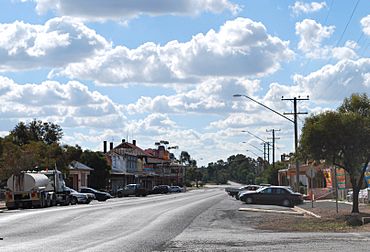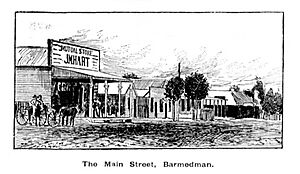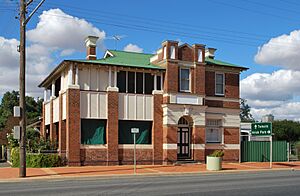Barmedman facts for kids
Quick facts for kids BarmedmanNew South Wales |
|
|---|---|

Main street of Barmedman
|
|
| Population | 212 (2011 census) |
| Postcode(s) | 2668 |
| Elevation | 262 m (860 ft) |
| Location |
|
| LGA(s) | Bland Shire Council |
| State electorate(s) | Cootamundra |
| Federal Division(s) | Riverina |
Barmedman is a small village in the New South Wales state of Australia. It's located in the Bland Shire, about halfway between West Wyalong and Temora. Barmedman first started as a place to support gold mining. Today, the area is mostly about farming. Farmers grow crops like wheat and canola, and they raise sheep. The village has two huge wheat silos that can hold over a million bushels of grain! In 2011, Barmedman had 212 people living there. The name "Barmedman" comes from an Aboriginal word meaning 'long water'.
Contents
History of Barmedman
Early Days and Gold Mining
In 1849, the 'Barmedman' land was used for grazing cattle. It was a huge area, about 36,000 acres. There was a special waterhole called the Barmedman Waterhole on this land. Later, in 1872, the Robertson brothers bought this land. One of them, Lachlan Robertson, lived there until he passed away in 1916.
Gold was discovered in 1874 at a place called Barmedman Reefs. This was on the 'Barmedman' land. Miners found gold in quartz rock. They used crushing machines to grind the rock into fine dust. Then, they used mercury to pull out the gold. This kind of mining needed many workers. They dug shafts, pulled out rock, and ran the machines.
By 1878, a pub and a store opened at Barmedman Reefs. A blacksmith and wheelwright also set up shop. Sadly, the pub and store owned by Mrs. Maher burned down in 1881. It was a very close call for her and her children.
Growing into a Town
The area was known as Barmedman Reefs until the early 1880s. After a gold rush in nearby Temora, the name became simply Barmedman. By 1882, Barmedman had two hotels. Soon, a third hotel opened too.
In August 1882, the government officially set aside land for the town of Barmedman. A public school opened in July 1883. By 1894, Barmedman had about 400 residents. The public school had 100 children attending.
Railways and Modern Services
The railway arrived in Barmedman in 1903. First, a line opened to Temora for goods. Later that year, it extended to Wyalong. In 1917, the line reached Lake Cargelligo. This connected Barmedman to the main railway system. In 1923, another railway line opened from Barmedman to Rankins Springs.
These new railway lines helped Barmedman grow. More businesses came to town. In 1924, a new community hall was finished. A two-story bank building was also built.
In 1940, Barmedman got a sewerage system. This was a big deal because Barmedman was a small town. It had about 500 people, but usually, only towns with 1,500 people got such systems. Barmedman also got a water supply and electricity from Burrinjuck Dam around this time.
In 1945, the town celebrated Sergeant Reg Rattey. He was born in Barmedman and won a very brave award called the Victoria Cross. He came back by train, and the whole town welcomed him. A band played, and people gave speeches. Reg Rattey was very humble. He said other soldiers were doing great jobs too, without recognition. The government later gave him a farm near Lake Cowell.
Sports in Barmedman
Rugby League History
Even though Barmedman doesn't have its own team anymore, rugby league is very popular here. In 1911, West Wyalong joined the New South Wales Rugby League. This was the first inland town in NSW to do so. Their team was called 'The Goldfields'.
In 1912, the Goldfields team played an exhibition match in Barmedman. Many people in Barmedman became fans of the game. By 1913, the Barmedman team was playing against the Goldfields team. After one game, a local newspaper gave Barmedman some funny advice. It said they should "study up the Rules" to avoid penalties!
The Barmedman rugby league team was known as the "mouse that roared." This was during the Maher Cup competition from 1920 to 1971. The Maher Cup was a challenge trophy. The team that won a match got to keep the cup. Barmedman didn't win every game, but they often beat teams from much bigger towns.
In 1929, Barmedman won its first Maher Cup. Their team was made up entirely of local players. They held the cup for five games in a row! In 1955, Barmedman beat Junee by a huge score of 72 to 3. This was the biggest win ever in Maher Cup history! The Barmedman Maroons had very passionate fans. Famous players like George Mason and Ron ('Dookie') Crowe even came to captain and coach the team.
Things to See and Do
Barmedman Mineral Pool
The Barmedman Mineral Pool is a special place. It started as a flooded gold mine! The water in the pool has a lot of minerals. It comes from underground water. People say the water has healing effects.
The pool is in a big park with shady grass. There are barbecues and change rooms. The Barmedman Mineral Pool is open from mid-October to the end of March. You can enter by making a donation. Sometimes the pool might be empty.
Annual Events
The annual Barmedman Show happens every year. It's on the first Saturday in September. The first event was in 1907. It was a Ploughing Carnival and Horse Parade. About 700 people came! They had ploughing contests and judged horses. There were also competitions for bread, butter, and jam. Today, the Barmedman Show is still going strong. It has carnival rides, horse events, and a 'Beaut Ute' competition. You can also see art, crafts, cooking, and farm displays. The show was cancelled in 2020 because of the Covid-19 pandemic.
Barmedman also hosts a Modified Tractor Pull competition. This usually happens in October. In this event, special tractors pull a heavy sled. The tractors are changed in different ways. There are categories like mini-modified and super-modified tractors. This popular event also has rides for kids, trade stalls, and other fun entertainment.




